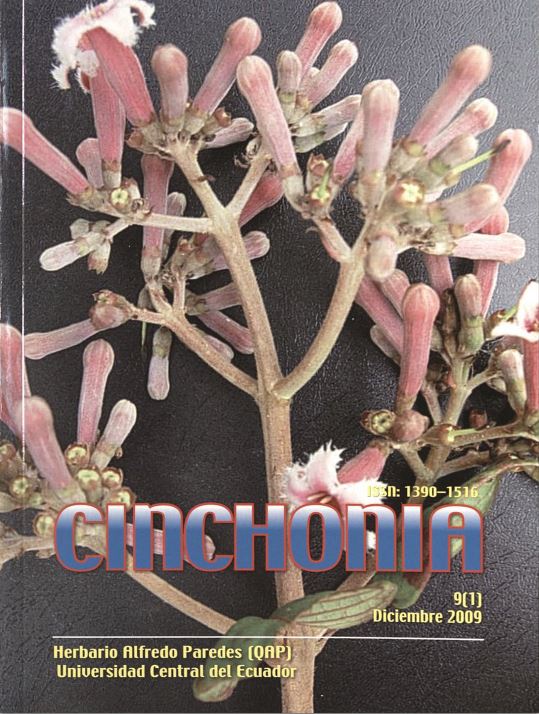MONDAÑA, RÍO ÑAPO - ECUADOR, DIVERSIDAD FLORÍSTICA MEDIANTE TRANSECTOS
Main Article Content
Abstract
By means of an invitation of Global Vision International and the Ecuadorian Museum of Natural Sciences, in March, 2007 the Mondaña’s forest was visited that administers this institution and realizes activities of ecological training. The area of study is in the left margin downstream from the Napo river, province of the same name, coordinates. 00°50.24’S - 77°13.55’W, high 350m, it corresponds to the zone of life humid tropical forest and to the vegetable formation always green forest of low lands. Three samplings were realized, two in hill (1 and 3) and one in the base of a hill (2), Cinchonia Vol. 9, # 1, 2009 51 in every locality the methodology was applied of transects of 0.1ha., radial model, the species analyzed were a 2.5cm. of DAP, the botanical identified collections are deposited in the herbarium QAP. For the analysis of the information it was used the Index of Simpson’s Diversity and that of Sorensen’s Similarity. The density ranges between 152 and 161 individuals, the alpha diversity between 66 and 73 species, three samplings add 146 species (diversity beta), in three cases the Index of Diversity is about the average diversity, the similarity ranges between 33.1% and 34.8%. The arboreal habit is the most dominant with 71.2%, followed by the arbustivo (13.7%), lianas (8.2%) and the rest with minor percentages. The five species most frequently in each sampling are: Iriartea deltoidea, Virola duckei, Leonia glycycarpa, Grias neuberthii, Perebea xanthochyma (hill 1); /. deltoidea, Tetrathylacium macrophyllum, Machaerium cuspidatum, Otoba parvifolia, G. neuberthii (base of hill); Oenocarpus bataua, P. xanthochyma, L. glycycarpa, I. deltoidea, Drypetes amazónica (hill 2). They are common to three samplings 16 species (11%). The results show an important variation of flowers between the samplings in small spaces of area, the diversity is an average compared with other Amazonian localities, there are evidences of the forest has had a selective utilization of species. This forest is an important tropical place for the biological practices that are realized by international students who come to our country across Global International Vision.

